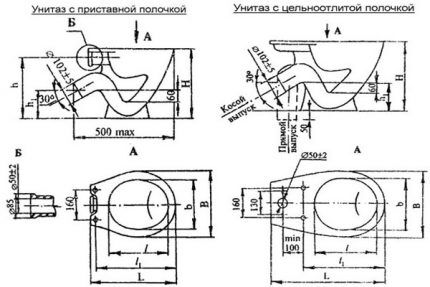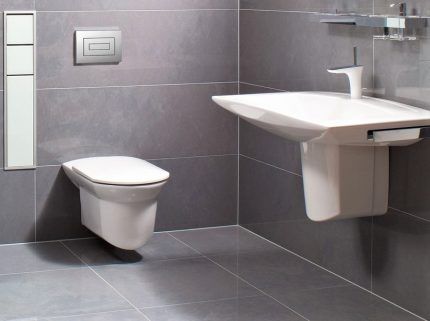Standard Toilet Sizes: Typical Dimensions and Weights of Different Types of Toilet
The toilet performs two useful functions: it is a necessary plumbing fixture and serves as a decorative element of the interior.
To make it comfortable to use plumbing, it is necessary to take into account such parameters as the size of the toilet. Properly selected dimensions create a favorable environment in the bathroom, which is important for the convenience and health of residents.
The content of the article:
Compactness or comfort?
Analysis of the technical characteristics of a plumbing fixture usually occurs before its purchase, and it refers to those items that are purchased not for a year or two, but for a longer period.
At this moment, it is important not to make a mistake by paying attention only to the design, type or method of connecting to communications.
In addition to the exact numbers that determine the width, height and length of the toilet, several generally accepted rules are important, which in the future will make its use as comfortable as possible:
As for the dimensions of the plumbing fixture, they are usually standard - with the exception of special models intended for use by children or people with disabilities.
Thus, the toilet should be comfortable for all family members and at the same time fit harmoniously into the interior of the bathroom or toilet. This is easy to achieve if you first, before purchasing, inspect the installation area and take simple measurements using a tape measure.
And you can ensure personal convenience right in the store - “try on” the model you like by simply sitting down on it.
Standards according to GOST
The provisions can also serve as a hint GOST 30493-96, which set out the requirements for sanitary ceramic products and indicate the standard sizes of typical toilets: plate, funnel-shaped and visor.
Dimensions are indicated for models with oblique and straight outlet, with and without a solid molded shelf.

To better understand the circuits of standard models, you can use the information given in the table.

If you combine the data, you get the following dimensions:
- Toilets with c/o shelf – 60.5*34-36*37-40 cm (l*w*h)
- Toilets without shelf – 46*34-36*37-40 cm (l*w*h)
- Children's models – 40.5*29*33.5 cm (l*w*h)
Of course, now GOST standards are not mandatory for the manufacture of sanitary products; many companies produce toilets according to specifications, which must be reported in the technical passport.
Accordingly, the dimensions will differ from those stated above.

It is impossible to force all kinds of design models, as well as products for people with disabilities, into a certain framework.
But most of the products presented in stores are still “standard” size toilets with a tank, that is, ordinary compact toilets priced at 7,000-15,000 rubles.
Features of the size range
In addition to products of standard sizes, which is what manufacturers strive for, there are a number of models that, due to the installation features, stand out from the general flow.
This also includes particularly large toilets, modern mini-models for children and specially designed sanitary fixtures equipped with devices for comfortable use by people with disabilities.
Option #1 - floor-mounted corner models
In small bathrooms, every centimeter of free space is important, so the product needs to be placed as compactly as possible and at the same time convenient for the apartment residents. Sometimes a corner is chosen for installation, and a corner model is purchased accordingly.

There are no difficulties with installing a corner toilet; the main thing is to prepare the place in advance, lay out communications and think through the connection.

The width and height of the model together with the cistern are 34-37*40-42 cm, but the length of this type of toilet, taking into account the non-standard shape, reaches 80 cm.
Remember that corners are not dimensionless, so in advance, armed with a tape measure, carefully measure the length of the walls of the installation area, not forgetting about the diagonal - the axis of installation of the corner toilet.
Option #2 - toilets with a built-in tank
To make the bathroom look more attractive overall, sometimes the tank, along with communications, is hidden behind a false wall made of plasterboard or plastic. Access to pipes and metering devices is through a sanitary hatch.

The space-saving effect is purely visual. It is clear that a false wall or partition steals part of the free space.
Therefore, the purpose of disguising the drainage device is rather aesthetic.

The average length of the bowl is 46-48 cm, width – 36-37 cm, height – 38-41 cm.
Option #3 - hanging bowls with installation
The peculiarity of hanging models is that they consist of 2 main parts, one of which is built into the wall, the second is located in the room.

An installation is installed behind the partition - a strong metal frame on which a toilet bowl suspended on studs is supported. The fittings are also located there - connections, drain mechanism, tank.
The bowl dimensions of a wall-hung toilet are most often standard:
- width – 37 cm;
- length – 46 cm;
- height above the finished floor – 39-41 cm.
But there may also be deviations from the standards, dictated by the features of the installation.

When choosing, be sure to check the dimensions of the frame - even with a compact bowl, it can be large and during installation will not fit into the niche allocated for it.
Option #4 - children's mini-models
Buyers with greater financial resources are usually interested in children's plumbing.
In addition, to install a mini-set, additional space is required - a second toilet.

The dimensions of children's plumbing fixtures are aimed at the age of children; accordingly, toilets for two-year-olds and 10-year-olds are different.

Plumbing fixtures for children all have smaller sizes than their adult counterparts:
- width – 27-30 cm;
- length – 38-40 cm;
- height – 30-40 cm.
It is wise to purchase special plumbing fixtures only for children, since teenagers feel quite comfortable on regular toilets.
Yes, and mini-toilets can be replaced with a special set: a child seat + a footrest.
Option #5 - large toilets
Unusually large toilets are rare - these are exclusive models made specifically for overweight or tall people.
However, sometimes a large device means the dimensions of the entire structure, with a toilet shelf and a cistern.

A large model requires more space than a regular model.
Even if the width of the toilet is larger than standard, this must be taken into account during installation - sometimes 2-3 cm makes a difference.

Products with unusually large bowl sizes are not in demand, so they simply cannot be found on the open market.
If there is a need to purchase a non-standard model, you will most likely have to place a special order.
Option #6 - special type of plumbing fixtures
Toilets for people with disabilities are also larger than usual, but not due to an enlarged rim, but due to additional devices.
Special armrests, handles, and stands help disabled people to sit comfortably on the seat.

The dimensions of the bowl are usually standard, and so is the tank, so there are no difficulties with installation. In addition to floor-standing models, you can also find hanging ones. But some models are equipped with a comfortable backrest, so the tank is slightly moved back - this increases the installation area.
Sometimes, in addition to the dimensions, the weight of the product is also important. You can find out how much the toilet weighs together with the tank from the technical documentation. Typically compact models weigh 20-25 kg, but much depends on the type of model and material of manufacture.
Conclusions and useful video on the topic
About sizes and more:
Children's toilet review:
The size of the toilet determines how comfortable you will feel in the toilet, so you should not ignore the height, dimensions of the rim and the design in general. Don’t forget that you have to deal with plumbing every day, so it should be as convenient, beautiful and safe as possible.



